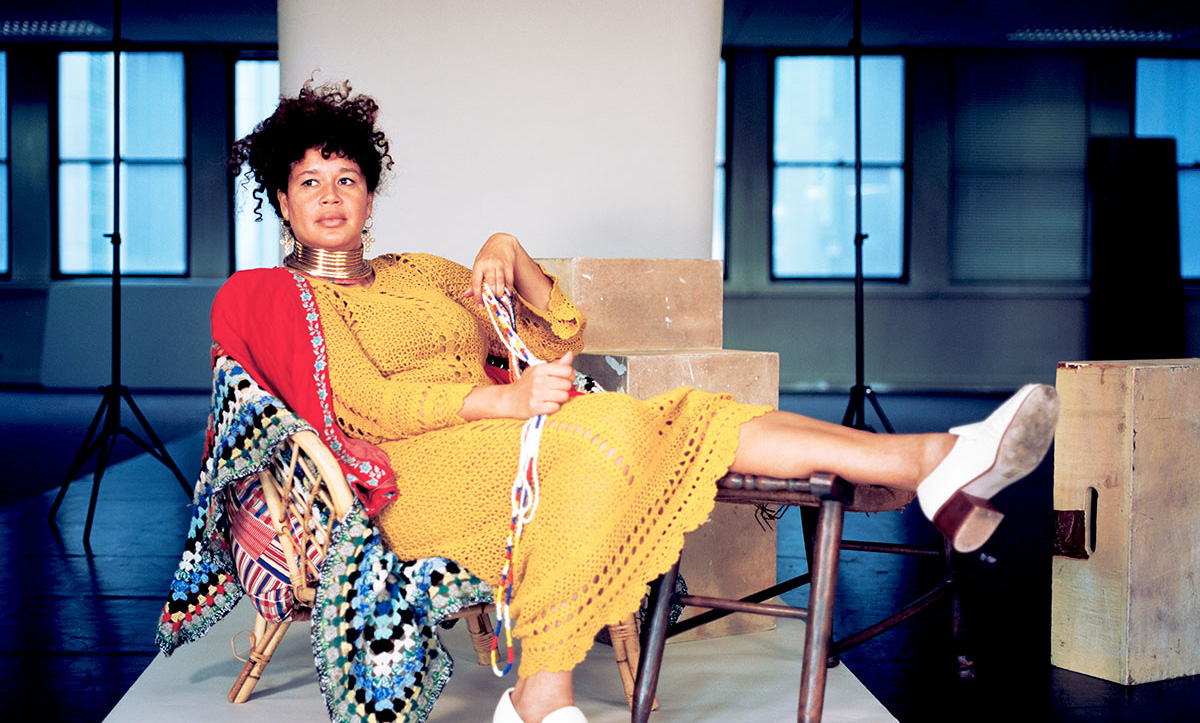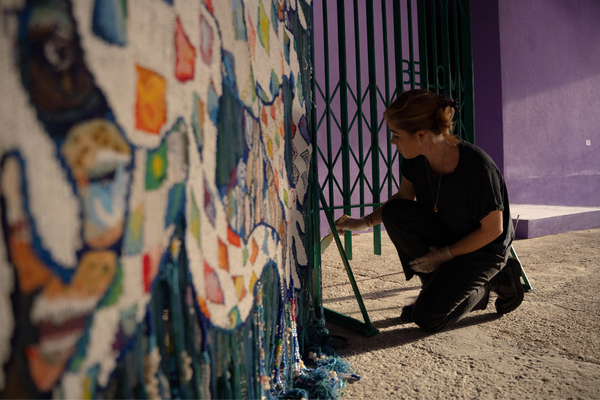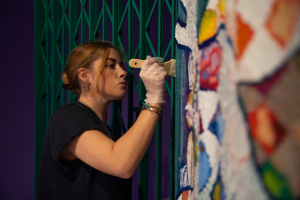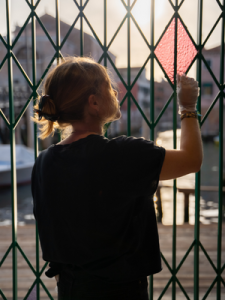9 November 2022 — Writing
Alice Rose Archer: Reflections on conservation


Alice Rose Archer is a preventive conservator originally from the UK and has been based in Venice, Italy, for nearly a decade. After graduating from the University of St Andrews in History of Art and Italian, she moved to Venice and worked on numerous exhibitions as a production manager and curatorial coordinator.
She then went onto receive an MA in Preventive Conservation from Northumbria University, informing her practice as a preventive conservator for projects exhibiting in Venice seeking to find appropriate and effective solutions to protect and sustain artworks on display and their surrounding environments. She will be presenting at the Sustaining Art: People, Practice, Planet in Contemporary Art Conservation Conference held in Dundee, Scotland, from the 9th to the 11th of November 2022.
In this piece, read her reflections on supporting the conservation of Alberta Whittle’s exhibition at the Arsenale Docks, S. Pietro di Castello.
For more information and preventive conservation consulting, Alice can be reached via email at [email protected].
As part of my research project for the MA course in Preventive Conservation at Northumbria University, Scotland + Venice generously allowed me to use Alberta Whittle’s deep dive (pause) uncoiling memory exhibition as a case study. I focussed on how preventive conservation practices could be sustainably applied in non-traditional exhibitions spaces, defined as venues that cannot undergo permanent or invasive structural changes including fixed air conditioning or environmental control measures. Essentially, finding sustainable solutions to best protect artworks and their surroundings when exhibiting outside of the traditional climate-controlled context of museums and galleries.
Preventive conservation differs from interventive conservation and restoration treatments in that it involves indirect actions aiming to avoid deterioration of artworks. This deterioration can be caused by aspects within the internal environment of the exhibition space such as incorrect temperature and humidity levels, light exposure, pollution, and so on, but also by external factors. For example, handling, storage, transport, and documentation are all areas where potential pitfalls can lie in wait. On top of that, there is the growing impact of climate change to consider as extreme weather patterns continue to threaten artworks through water or fire damage and plans need to be put in place to quickly react to any disasters that may occur.
It is a complex and hefty undertaking, particularly when artworks are housed in untraditional venues that have a limited capacity to control the internal space. In this sense, deep dive (pause) uncoiling memory was an ideal case study. Presented in an ex-industrial boat warehouse with little separation between the internal and external environments subject to Venice’s unique weather patterns bringing temperature and humidity fluctuations and regular flooding, our work was certainly cut out for us.

Alice Rose Archer working on the conservation of the tapestry in Venice that forms part of deep dive (pause) uncoiling memory. Image: Joe Satorius
It was also important to me, Scotland + Venice, and Alberta that we made sure all actions were rooted in sustainability – economic, environmental, and social. The experience was incredibly informative and I was able to find ways in which preventive conservation can be simultaneously effective and sustainable. Making sure textile elements were kept out of direct sunlight, routinely removing dust and debris from the space and the artworks, and establishing a flood prevention and management plan are just a few examples of how preventive conservation can play an important role in exhibition management. The risk of flooding in Venice, known as acqua alta literally translating to ‘high water’, was arguably the biggest challenge, and figuring out how to best protect the artworks required considerable thought and teamwork.
Putting into place preventive conservation measures that were realistic and sustainable, using local resources and knowledge, was the core of the research project but the most rewarding part for me personally was the level of collaboration displayed by everyone involved. Venice is a double-edged sword in many ways. It is a beautiful city full of incredible art, but it can also be unpredictable and demands patience. There is no such thing as next day delivery or jumping in a taxi when you are in a rush! This means that people must work together, creating networks of support within the city and beyond.
The Professional Development Programme run by Scotland + Venice is a testament to this, and the opportunity to share preventive conservation knowledge with those on the programme was a real highlight for me. The support provided by those working on the project, particularly Louise Briggs, was never-ending and demonstrated a true investment in the cultural heritage of both Scotland + Venice.
Coincidentally, I was on placement at The Scottish National Gallery of Modern Art earlier in the year working in the conservation department, and knowing that Alberta’s work will travel there after the Biennale brings a satisfying symmetry to the project. For those living and working in Venice, it can feel like a very transitory place with people coming and going, often not contributing to the future survival of Venice and its residents.
This is what sets Scotland + Venice apart. Taking an exhibition space on a long-term basis, educating young practitioners in Scotland, and involving local people in Venice is a refreshing take on the temporary exhibition format. I very much hope to be able to collaborate with Scotland + Venice and their upcoming projects in Venice as a preventive conservator, and to demonstrate the importance of sustainable preventive conservation and its role in conserving cultural heritage and the surrounding communities.

Alice Rose Archer in front of one of the gates created as part of Alberta Whittle’s Venice exhibition, deep dive (pause) uncoiling memory. Image credit: Joe Satorius

